Frequency transposition applications for improving spatial hearing abilities of subjects with high-frequency hearing losses
a technology of high-frequency hearing loss and transposition frequency, applied in the field of transposing frequencies to improve the spatial hearing ability of subjects with high-frequency hearing loss, can solve the problems of reduced spatial hearing ability, and most often difficult to detect high-frequency sound signals, so as to improve the spatial hearing ability of subjects, reduce spatial hearing abilities, and significantly improve the effect of spatial hearing abilities
- Summary
- Abstract
- Description
- Claims
- Application Information
AI Technical Summary
Benefits of technology
Problems solved by technology
Method used
Image
Examples
Embodiment Construction
[0051]In the following description, reference is made to the accompanying figures, which show by way of illustration how the invention may be put into practice.
[0052]In FIG. 1 the overall process of configuring and implementing a subject-dependent frequency transposition scheme is displayed. In initial step 101, the subject's residual hearing sensitivity is determined by means of standard audiometric measurement procedures [e.g. Arlinger, S. (1991), Manual of Practical Audiometry—Volume 2, London: Whurr Publishers Ltd.]. Estimates of hearing thresholds are thereby obtained that reveal the subject's configuration and degree of hearing loss. If a relatively mild hearing loss is diagnosed, the subject should have sufficient residual frequency resolution to resolve finer spectral cues [e.g. Moore, B. C. J. (1998), Cochlear Hearing Loss, London: Whurr Publishers Ltd.]. By contrast, if a more pronounced hearing loss is diagnosed, the subject's frequency resolution is likely to be severely...
PUM
 Login to View More
Login to View More Abstract
Description
Claims
Application Information
 Login to View More
Login to View More - R&D
- Intellectual Property
- Life Sciences
- Materials
- Tech Scout
- Unparalleled Data Quality
- Higher Quality Content
- 60% Fewer Hallucinations
Browse by: Latest US Patents, China's latest patents, Technical Efficacy Thesaurus, Application Domain, Technology Topic, Popular Technical Reports.
© 2025 PatSnap. All rights reserved.Legal|Privacy policy|Modern Slavery Act Transparency Statement|Sitemap|About US| Contact US: help@patsnap.com



